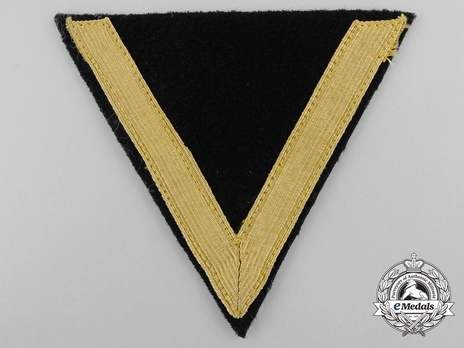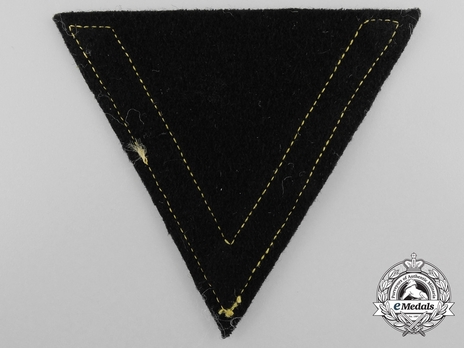Kriegsmarine Obermatrose Chevron
CATEGORY: Version
SKU: 21.GOR.03.02.07.005.000
Estimated market value:


Estimated market value:
Yellow embroidered nylon stripe, cut and folded at the mid-point and forming a chevron, sewn in place via yellow threading on an inverted black wool base, 75 mm x 86 mm, extremely fine.
The headgear, uniforms, and insignia worn by members of the Kriegsmarine were based upon the designs utilized by the Kaiserliche Marine and the Reichsmarine. The official regulations governing the uniforms of the Reichsmarine were issued on April 5, 1921, and they were embraced, with a few alterations, as the Kriegsmarine uniforms in 1935. New guidelines concerning rank insignia were issued in 1933, 1935, 1936, 1938, and 1940.
The Chevrons were worn by all Kriegsmarine Privates, excluding cadets. The number of chevrons, and any additional elements, corresponds with the wearer’s specific rank. The chevrons were worn above the wearer’s elbow, and they were often worn in conjunction with career insignia. The career insignia were worn immediately above the chevron insignia.
There were several changes in Kriegsmarine Private ranks over time, and these title changes often corresponded with modifications in the association chevron. Also, throughout the various rank title changes the chevron insignia designs were recycled.
From 1933-1935 the ranks were as follows: Obermatrose, Gefreiter, Obergefreiter, and Stabsgefreiter.
From 1935-1937 the ranks were as follows: Obermatrose, Stabsmatrose, and Oberstabsmatrose.
From 1937-1938 the ranks were as follows: Obermatrose, Stabsmatrose, Oberstabsmatrose, Obergefreiter (with more than 6 years), and Stabsgefreiter.
From 1938-1940 the ranks were as follows: Gefreiter, Obergefreiter, Hauptgefreiter, Obergefreiter (with more than 6 years), and Stabsgefreiter.
Lastly, from 1940-1945 the ranks were as follows: Gefreiter, Obergefreiter, Hauptgefreiter, Stabsgefreiter, and Oberstabsgefreiter.
The exact colour scheme of the chevron insignia depends on the uniform on which it was originally worn. Wherein the triangular backing of the chevrons generally matches the colour of the uniform on which it was worn.
For the blue service uniform the chevrons were composed of matte gold-coloured tress, yellow-coloured cloth, yellow-coloured braided soustache, or light/cornflower blue ribbon. These chevrons were generally worn on a blue triangular backing.
For the white summer version of the blue service uniform the chevrons were composed of blue coloured cloth. These chevrons were generally worn on a white triangular backing.
For the tropical service uniform the chevrons were composed of cornflower blue coloured cloth. These chevrons were generally worn on a field-grey or brown triangular backing.
For the field-grey service uniform the chevrons were composed of matte gold-coloured tress, yellow-coloured cloth, yellow-coloured braided soustache, or golden-yellow coloured piping, artificial silk, or cotton. These chevrons were worn on either a dark green/bluish triangular backing, or a field-grey triangular backing for wartime use.
For the brown tropical uniform the chevrons were composed of matte gold-coloured tress or yellow-coloured soustache. These chevrons were worn on a brown triangular backing.
These chevron insignia were also known as sleeve ratings.
The Obermatrose rank was the highest rank of Kriegsmarine Privates from 1933-1938. In 1938, the Obermatrose rank was replaced with the Grefreiter rank.
The Obermatrose chevron insignia generally features a single chevron on the triangular cloth backing.

Comments
Sign in to comment and reply.


Scroll Top